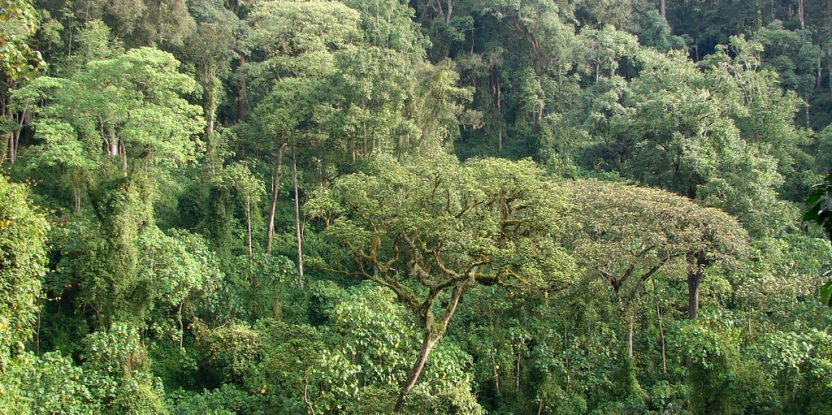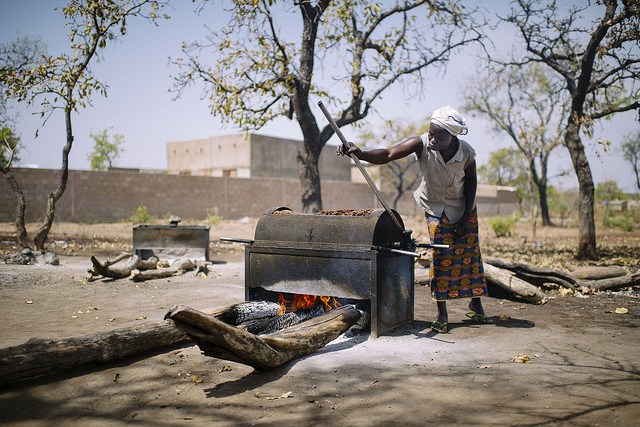
Protecting tropical forests in Africa often means directing conservation and law enforcement efforts towards fighting illegal logging, hunting and poaching.
But scientists at the Center for International Forestry Research (CIFOR) decided to take a closer look at a largely overlooked challenge – the collection of firewood.
In many parts of world, fuel wood is the main source of energy. That is especially the case in sub-Saharan Africa, where rural communities depend on wood and charcoal to cook meals, boil bathwater and heat their homes.
Much of that wood is collected from tropical forests, including from national parks that are home to endangered primates, elephants and big cats. Yet, until now, there has been very little research on the impact, if any, this wood collection is having on local flora and fauna.
Douglas Sheil of the Norwegian University of Life Sciences and doctoral student Marieke Sassen of Wageningen University in the Netherlands decided to examine fuel wood collection in the forests of Mt. Elgon National Park in Uganda. Located near the Kenyan border, this park is known for its vast collection of rare plants and is home to more than 300 species of birds, as well as a 4,321-meter-high extinct volcano that is believed to be nearly 24 million years old.
“During my research at Mt. Elgon, I found that illegal fuelwood comprised the most important use of the forest, following agriculture and grazing,” Sassen said.
“Then, during my follow-up study of human impacts on forest structure and species richness, I found indications that allowing people to collect fuel wood also possibly contributed to forest degradation and slowed down regeneration, so I decided to investigate this further.”
DEMAND AND DEGRADATION
After conducting surveys and interviews with nearly 200 households, the researchers found that wood collection had an impact on the park, especially up to a thousand meters from the park’s boundary and the densest portion of the park.
The most popular species of trees were also those favored for timber use like Prunus Africana, Popocarpus milianjianus and Allophylus abyssinicus.
“Demand for wood fuel from tropical forests is still likely to grow in the foreseeable future,” the researchers wrote in their study.
“Our results indicate that the forest may become more degraded as a result, with negative consequences for conservation, as well as for the people who depend on the forest.”
Sheil described wood collection as “a major, but very localized threat if not well-controlled.” He added that people used the opportunity to cut trees, set snares and engage in other illegal activities.
“In many larger, less densely-populated forests, there are bigger threats like land-clearing for large-scale agriculture, grazing or plantations,” he said. “Those threats are more severe and more likely to be permanent.”
“But fuel wood collection is significant near forest edges where forests occur in areas with dense human populations that live mainly on subsistence lifestyles. So this is certainly a problem in many other East African forests.”
CREATING LOCAL SOLUTIONS
The authors cautioned that it wouldn’t be easy to combat the problem with measures like limiting access to the park, since so many rural communities depend on fuel wood for their survival. In many cases, they have no alternative sources of energy, nor the money to buy wood from other places.
Poor people should not become further impoverished because of forest conservation
Complicating matters, Sheil added, is the colonial legacy that colors the debate in places like Uganda, where many parks were established during British rule and included controversial measures like evicting entire communities in the name of conservation. Park access thus remains a sensitive topic, and calls to open parks to farmers and others are a common campaign issue during elections, according to Sheil.
“Excluding people will make them even more hostile and less supportive of the park,” he said.
“So it is a balancing act. My own feeling is that we can permit firewood collection if we can also set up a process to require those involved to accept a role in protecting the park. It’s not easy to do, but conservation is seldom simple.”
What is evident, however, is that any solution must fully consider the needs of the local population living around the park.
“You are talking about communities that have been accessing these forests for generations,” said Sheil. “They have never needed to collect firewood anywhere else before.”
“Poor people should not become further impoverished because of forest conservation,” Sassen added. “Morally, this does not make sense and it can also lead to conflicts. Conflicts over forest resources rarely benefit conservation or local people.”
COMING TO AGREEMENT
In order to limit damage to the forest, the authors said the answer may lie in giving communities a greater say in park management – under a system where the law-abiding residents would help authorities prevent those who are carrying out illegal activities like logging or laying snares.
Presently, the park has agreements allowing legal access to collect wood, but turns a blind eye to others to avoid conflicts.
“Park management lacks the means to enforce the rules of the agreements and local forest user committees are unable to or unwilling to impose them,” the study concluded.
“What I would like to see is a much more conditional form of access where you negotiate with the local people and say if we are going to allow you to continue this, we need to agree on some rules and you agree that you help police these rules,” Sheil added.
We want you to share Forests News content, which is licensed under Creative Commons Attribution-NonCommercial-ShareAlike 4.0 International (CC BY-NC-SA 4.0). This means you are free to redistribute our material for non-commercial purposes. All we ask is that you give Forests News appropriate credit and link to the original Forests News content, indicate if changes were made, and distribute your contributions under the same Creative Commons license. You must notify Forests News if you repost, reprint or reuse our materials by contacting forestsnews@cifor-icraf.org.
